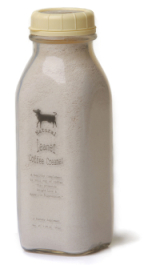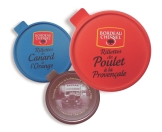Loop closes on food-contact recycling
Customers call for creative packaging
Tomato supply chain guidelines updated
Companies to pay more for COOL
Powdered creamer in “milk” bottle
French faux pâtés use laminated lids

Loop closes on food-contact recycling
by Pan Demetrakakes
Executive Editor
So-called “closed-loop recycling,” in which packaging materials are recycled into more packaging materials, has always been a niche business.
Regulations both in the U.S. and abroad severely restrict the use of recycled material in packaging that has direct contact with food. This is why most recycled plastic packaging ends up in textiles or other non-food-related products. Even when recycled material gets reused as packaging, it’s likely to be non-contact packaging like shipping cases.
But factors like increased interest by the trade and consumers in packaging “sustainability,” and rising prices for virgin plastic and other packaging materials, have renewed interest in closed-loop, food-contact recycling, both here and abroad:
● ConAgra Foods has begun transitioning to post-consumer recycled plastic in almost all the trays for its frozen foods, which include the Healthy Choice, Banquet, Kid Cuisine and Marie Callender’s lines. The crystallized polyethylene terephthalate (CPET) trays, furnished by Associated Packaging Technologies, will have 30% to 40% post-consumer content. ConAgra estimates this will save 8 million pounds of discarded plastic and more than 15,000 tons of carbon emissions annually.
● A recycling plant in England, opened in June, will handle 35,000 tons a year of plastic bottles, turning them into recycled raw material for new food and drink packaging. The Closed Loop Recycling Ltd. plant, billed as the first facility in the United Kingdom to recycle plastic bottles into food packaging, counts Coca-Cola Enterprises and the Marks & Spenser grocery chain among its initial customers.
● Also in England, the Asda grocery chain (a unit of Wal-Mart) is test-marketing a milk jug that consists of a molded-pulp outer shell and a bag made from corn-derived bioplastic. The shell is made from 91% recycled material, primarily office paper. Asda is trying out the package, trade-named GreenBottle, in one of its stores and is considering a nationwide rollout.
Meeting regulatory requirements for food-contact recycled materials can be tricky. In theory, the U.S. Food and Drug Administration (FDA) doesn’t approve methods or procedures for manufacturing food-contact plastics, only the materials themselves. But in practice, plastics processors often seek FDA approval (technically, a “no-objection letter”) for a specific recycling process. The FDA has issued more than 100 such letters for food-contact recycled plastics since 1990.
One of the most significant changes to FDA policy occurred in March, when the agency ruled that “tertiary recycling” for PET (defined as “subjecting post-consumer plastic packaging to chemical treatment whereby its components are isolated and reprocessed for use in manufacture”) need no longer be covered by a no-objection letter.
Closed-loop recycling for food packaging will continue to be expensive and difficult, especially for plastics. But if prices and consumer attitudes continue to exert enough pressure, more companies may take the plunge for the long-term investment needed to do this kind of recycling.
TOP DEVELOPMENTS
Customers call for creative packaging
While most U.S. consumers will not change over to a private brand from a preferred brand during uncertain economic times, they do want manufacturers and retailers to be more creative in product packaging and sales approaches, according to a recently released Unilever study. Shoppers’ preferences included introducing larger package sizes, smaller package sizes at lower prices and modestly reduced package sizes at the same price. The least preferred option was to introduce slightly lower quality items at the same price.
Tomato supply chain guidelines updated
The United Fresh Produce Association and the North American Tomato Trade Work Group have published the second edition of “Commodity Specific Food Safety Guidelines for the Fresh Tomatoes Supply Chain” to offer advice on food safety in supply chains. The updated version includes new scientific principles and viewpoints from a wider range of contributors. One packaging guideline that stands out calls for primary and secondary packaging to be coded to ensure traceability. Other guidelines call for a system to prevent use of contaminated or damaged cartons and trays, identification for packaging materials that come in contact with fresh-cut tomatoes, and instructional labels about sanitary storing methods.
Companies to pay more for COOL
American companies will spend $2.5 billion next year to obey country-of-origin labeling laws, according to the U.S. Agriculture Department. The latest estimate states that the average individual U.S. producer will shoulder initial costs of $376, and the average U.S. retailer will face initial costs of $26,149. While consumers may end up shouldering some or all of these costs, they will know where products originate, and thus be able to pick foods more carefully. “To me, it is scary to buy food that you don’t know how or where it was grown,” Paula Quell, a resident of Merriam, Kan., told the Agriculture Department. One estimate puts retailer implementation costs at 7 cents a pound for beef and 4 cents a pound for pork.

NEW PACKAGES
Powdered creamer in “milk” bottle
A coffee creamer that claims nutritional benefits comes in a glass bottle that resembles a delivered quart of milk. Java Solutions, Los Angeles, is marketing Leaner Coffee Creamer, a dairy-free product with hoodia and bitter orange extract. The powdered creamer comes in a 9.35-ounce glass bottle with the square base and round shoulders associated with milk deliveries. A closure rimmed with ridged plastic contributes to the milk-bottle reference.

French faux pâtés use laminated lids
A laminated lid is being used by a French processor to give a sophisticated look to containers of pâté analogs. Luisser Bordeau Chesnel is using plastic containers with in-mold labels for Rillettes, meat-based pastes similar to pâté. To top the containers, the company is using laminated lids from RPC Tedeco-Gizeh Troyes, which have a “soft touch” similar to the label on the container’s walls.
